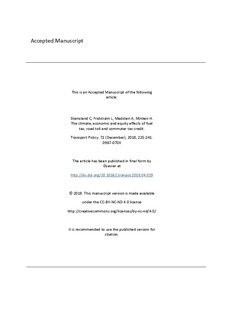| dc.description.abstract | State-of-the-art travel demand models for Norway have been run with the aim of revealing the equity effects of selected policy measures for greenhouse gas abatement. The Oslo Intercity Regional Model, comprising roughly 43 per cent of Norway's five million population, was used to study short distance trips in southeastern Norway, i. e. in and around the capital city of Oslo. The NTM6 model for domestic, long distance travel was used to analyze domestic trips longer than 70 km one way. Both of these are network models of travel demand, predicting car ownership, trip frequency, destination choice, mode choice and route choice under user specified input assumptions. The following three policy options have been studied: (i) tripled toll rates and ferry fares everywhere in Norway, (ii) a NOK 0.20 (= € 0.024) per vehicle km road charge or equivalently higher fuel tax, and (iii) abolishment of the commuter tax credit, which in 2014 amounted to roughly € 0.05 per km for long-distance commuters. By design, these three policy options give rise to similar reductions in CO2 emissions from travel. While option (i) turns out to be highly inefficient, options (ii) and (iii) appear, in a partial travel demand analysis, to be welfare increasing even before CO2 abatement benefits. However, when the policy options are ordered according to their equity effects, the ranking becomes completely reversed. The abolishment of the commuter tax credit appears to hit people in low income neighbourhoods five to fifteen times harder than those living in high income zones. The fuel tax increase gives rise to corresponding inequity ratios between three and seven. The main explanation is that residents of remote, low income areas generally sustain longer commutes, and also to a larger extent depend on their cars for commuting than do workers in densely populated urban or suburban districts. | nb_NO |

